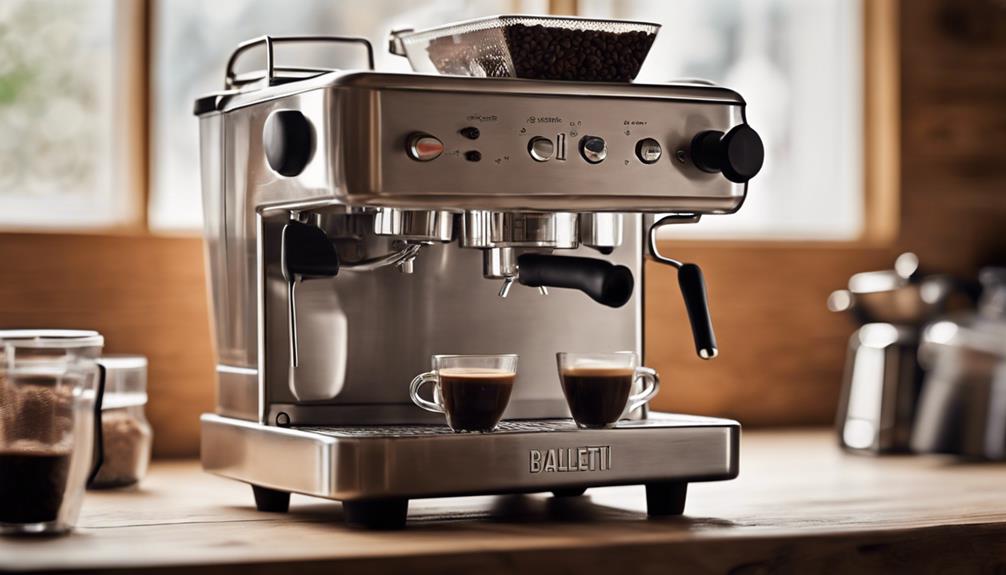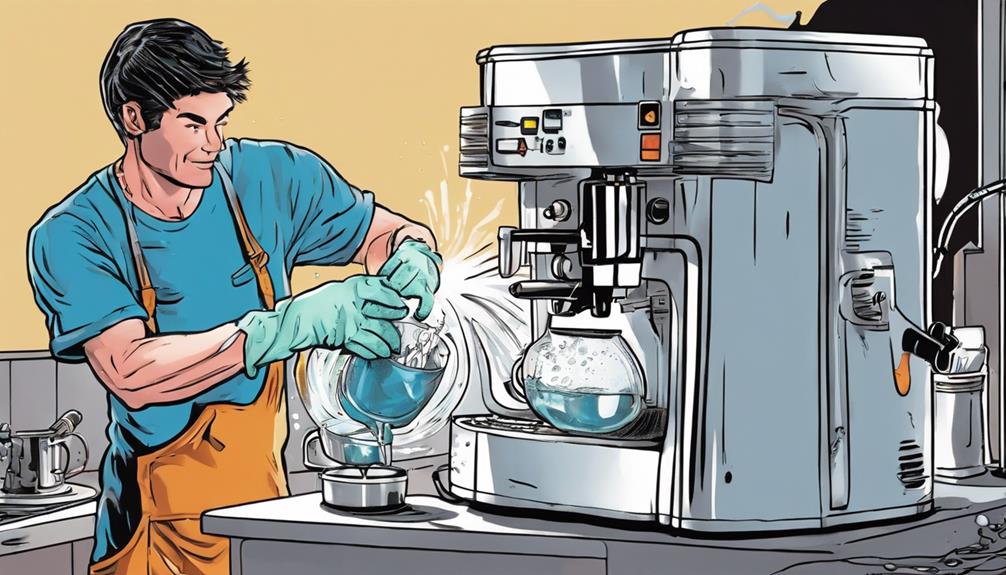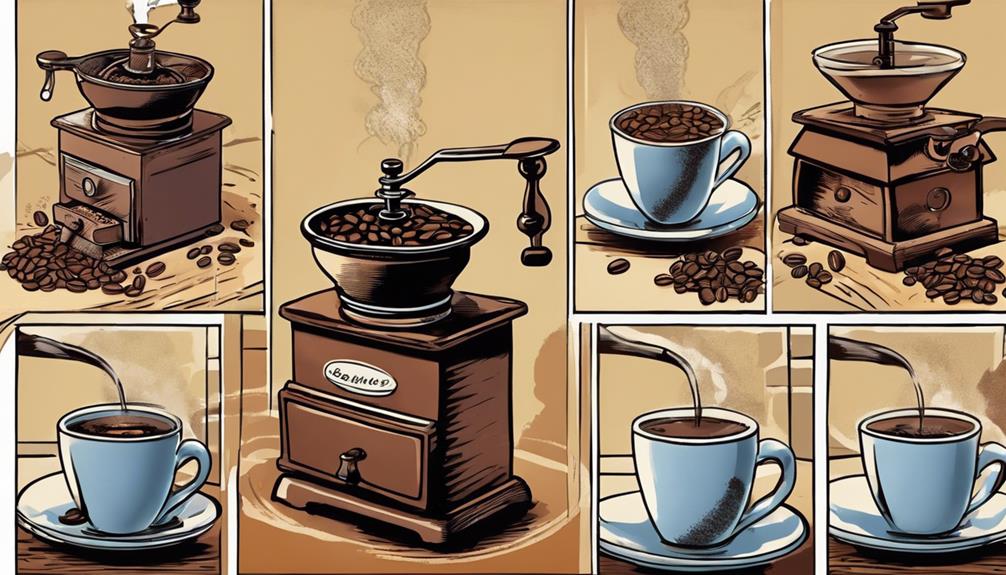To achieve pour-over perfection at home, it is essential to have the right gear such as a kitchen scale, burr grinder, and a gooseneck kettle for precise pouring. Mastering the technique involves controlling your pour, blooming the grounds, and maintaining a steady spiral motion. Water quality is crucial; using clean water at 205°F is key. Grinding fresh beans with a burr grinder and adjusting the grind size for optimal extraction is necessary. Experimenting with different coffee-to-water ratios can customize the flavor. The pour-over process provides control and results in a flavorful cup of coffee. Factors to consider include ratio, grind size, brew time, temperature, and agitation. Enhance your brew with tips like adding maple syrup or using a thermal carafe.
Key Takeaways
- Use a gooseneck kettle for precise pouring control.
- Follow a consistent pouring technique for uniform saturation.
- Grind coffee beans freshly with a burr grinder.
- Experiment with coffee to water ratio for optimal flavor.
- Blooming the grounds and spiraling pour enhances extraction.
Essential Pour-Over Gear
To brew pour-over coffee at home successfully, you'll need to gather essential gear that includes a kitchen scale, coffee scale, gooseneck kettle, burr grinder, and timer for precise brewing.
The grind size plays an essential role in achieving the perfect cup of coffee. With a burr grinder, like the OXO Brew Conical Burr Coffee Grinder, you can guarantee a consistent grind size that's neither too coarse like what's used for a French press nor too fine.
The gooseneck kettle, such as the Fellow Stagg EKG Electric Pour-Over Kettle, provides the precision pouring control necessary for even extraction.
Perfecting the Pour

Perfect your pour-over coffee brewing technique by mastering the art of controlled and consistent pouring for best flavor extraction.
Start by blooming the coffee grounds with a pour of hot water to enhance flavor extraction.
Slowly pour the water in spirals over the grounds, ensuring even saturation and a balanced extraction.
Utilize a gooseneck kettle for precise pouring control throughout the brewing process.
Maintaining a steady pour is essential to achieving uniform saturation and best extraction from the coffee grounds.
By following these pouring techniques, you can attain a clean and smooth extraction for a delicious cup of pour-over coffee.
Remember, the grind of your coffee beans, the water temperature, and the pouring method all play vital roles in perfecting your pour-over brew.
Practice your pouring technique to elevate your coffee brewing skills and savor the rich flavors of a well-executed pour-over coffee.
Water Quality

You must pay attention to the quality of the water you use for brewing pour-over coffee.
Best brewing water temperature is essential for extracting the finest flavors from your coffee grounds.
Using clean, drinkable water will greatly impact the taste of your final brew.
Water Temperature
Maintaining clean water quality greatly influences the flavor profile of your pour-over coffee brew. One vital aspect to bear in mind is the water temperature. The best brewing temperature for pour-over coffee is around 205 degrees Fahrenheit. Using water at this temperature guarantees proper extraction of flavors from the coffee grounds, resulting in a delightful and aromatic cup of coffee. It is important to note that water quality plays a significant role in achieving the desired taste in your brew. The table below summarizes the key points to remember when it comes to water temperature and quality in pour-over coffee brewing:
| Water Temperature | Water Quality |
|---|---|
| Optimal: 205°F | Use clean water |
| Essential for flavor | |
| Impact on brew taste | |
| Maintain quality |
Clean Water
Quality water is necessary for achieving the best flavor in your pour-over coffee brew. When brewing your favorite cup of pour-over coffee, make sure you're using clean water to enhance the overall taste and aroma.
Here are three key points to keep in mind:
- Water Quality: Using clean, fresh water is vital as any impurities or off-flavors in the water can impact the final taste of your coffee.
- Water Temperature: Aim for a water temperature around 205 degrees Fahrenheit for optimal extraction. The right temperature helps in releasing the flavors from the coffee grounds without scalding them.
- Flavor Enhancement: Maintaining water quality ensures that your pour-over brew remains clean and flavorful, free from any unpleasant aftertastes. Investing in good quality water can greatly enhance the taste experience of your coffee.
Grinding Techniques
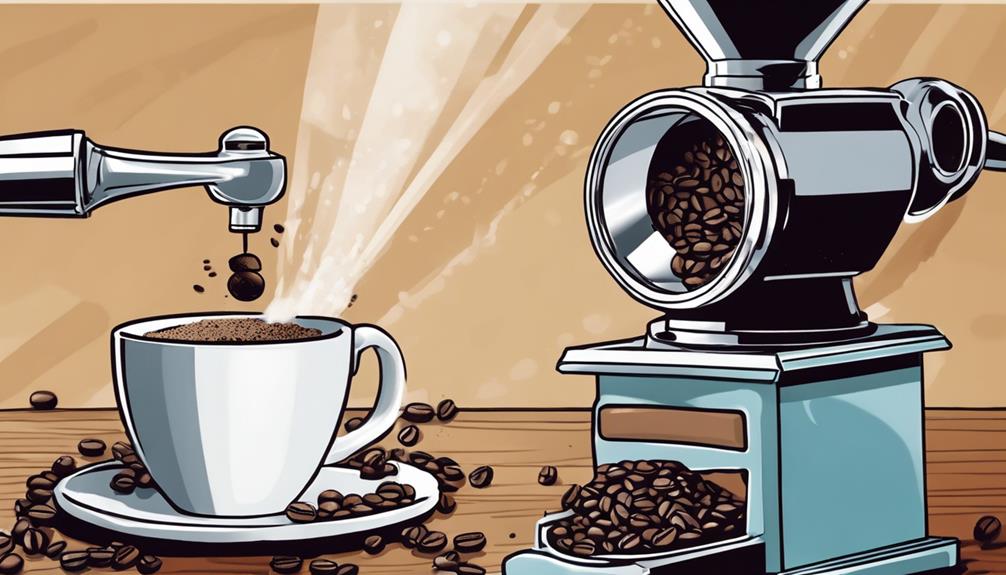
For peak flavor extraction in your pour over coffee brewing process, the key factor to think about is the grinding technique you employ. Freshly grinding your coffee beans is essential to avoid oxidation and guarantee the best flavor in your cup.
The grind size plays a significant role in the extraction process. Adjusting the grind size based on your taste preferences is vital for a balanced and flavorful brew.
When selecting a grinder, consider using a burr grinder for a consistent particle size, which leads to even extraction of flavors from the coffee grounds. Consult your grinder's guide for recommended settings to achieve the desired grind size.
Baratza electric grinders are highly recommended for their quality and performance in grinding coffee beans. By paying attention to your grinder, grind size, and using a burr grinder, you can enhance the overall quality of your pour over coffee brewing experience.
Ratio Adjustment
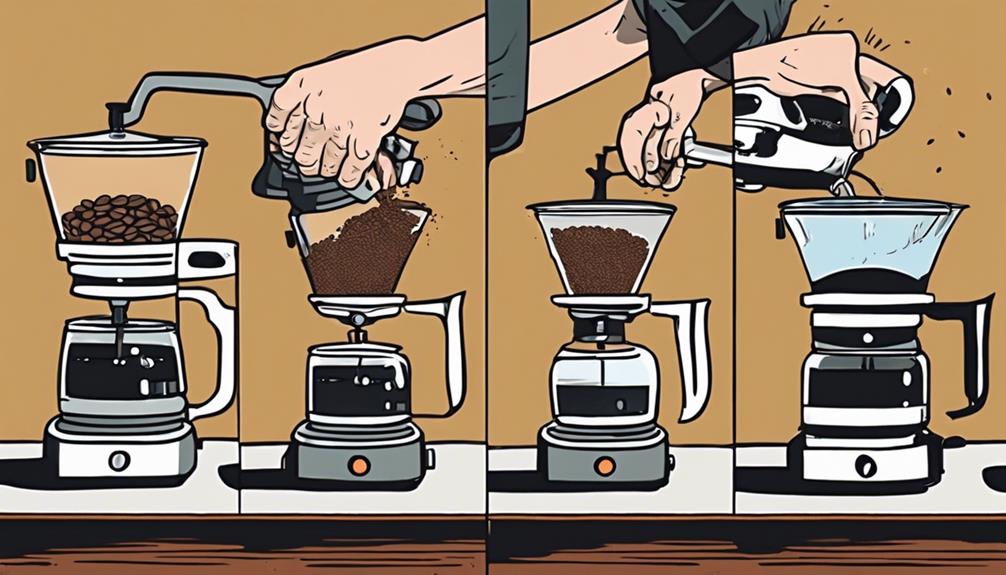
To ensure a well-balanced and flavorful pour-over coffee, adjusting your coffee to water ratio is key in enhancing the extraction process.
Here are three essential tips to help you achieve the perfect brew:
- Maintain Consistency: Start with a general coffee to water ratio of 1:17 to guarantee a well-rounded flavor profile. For example, for a Chemex brew, try using 42g of coffee with 700g of water. Adjust the ratio based on your taste preferences.
- Fine-Tune Grind Size: Experiment with grind size to control the extraction process. Finer grinds work well for weaker or sour flavors, while coarser grinds can help balance out bitter notes. Finding the right grind size can optimally impact the overall taste of your coffee.
- Optimize Flavor Extraction: The proper coffee to water ratio is essential for optimal flavor extraction. By adjusting this ratio and experimenting with different combinations, you can tailor your pour-over coffee to suit your unique taste preferences.
Pour-Over Brewing Process

Mastering the art of pour-over brewing involves the precise hand-pouring of hot water over coffee grounds in a filter to extract rich flavors and oils. The brewing process gives you complete control, allowing for a customized coffee experience tailored to your preferences.
Pour-over coffee is renowned for its ability to produce a flavorful cup due to the meticulous extraction it offers. By moving away from automatic coffee makers, the pour-over method provides a hands-on and engaging brewing experience that many coffee enthusiasts appreciate.
Achieving the perfect pour-over coffee involves paying close attention to details like water temperature, pour rate, and bloom time. These factors play an essential role in determining the quality and taste of your final cup.
With practice and attention to these elements, you can elevate your coffee game and enjoy a truly exceptional brew every time.
Variables Affecting Extraction

When making pour-over coffee at home, you should pay attention to essential variables that impact extraction. Factors like coffee to water ratio, grind size, brew time, temperature, and agitation play a significant role in the final flavor of your brew.
Understanding and adjusting these variables will help you achieve a more personalized and best coffee experience.
Extraction Influencing Factors
Factors influencing extraction in pour-over coffee brewing include the coffee to water ratio, grind size, brew time, brew temperature, and agitation.
When considering these variables, keep in mind the following:
- Grind Size: The size of your coffee grounds greatly impacts extraction. Finer grounds increase surface area contact with water, leading to a faster extraction process. Conversely, coarser grounds may result in under-extraction if not brewed long enough.
- Extraction: Achieving the best extraction percentage of 19-22% is essential for a balanced flavor profile. Monitoring extraction levels helps prevent over or under-extraction, ensuring a delicious cup of coffee every time.
- Brew Temperature: The temperature at which you brew your coffee affects extraction. Ideally, water temperature should be between 195-205°F (90-96°C) to facilitate the extraction of desirable coffee compounds without scorching the beans.
Brewing Variable Impact
Roasted coffee composition, particularly the ratio of insoluble cellulose to soluble compounds, plays a significant role in influencing extraction when brewing pour-over coffee at home. Understanding the brewing variable impact is essential for achieving the perfect cup.
The coffee-to-water ratio is a key factor that determines the strength and flavor of your brew. A higher ratio will result in a stronger coffee, while a lower ratio will be milder.
Additionally, grind size plays a critical role in extraction. Finer grinds increase surface area contact, allowing for a quicker extraction, while coarser grinds slow down the process.
Adjusting these variables can help you fine-tune your pour-over brewing technique to achieve the desired flavor profile. Experimenting with different ratios and grind sizes will allow you to discover the perfect balance that suits your taste preferences.
Additional Tips and Enhancements

Consider improving your pour-over coffee experience at home with these simple tips and tweaks.
- Add a Touch of Sweetness: Elevate your pour-over coffee by adding a hint of maple syrup for a natural and unique sweetness that complements the rich flavors of the coffee beans.
- Keep It Warm: Invest in a thermal carafe or insulated mug to maintain the perfect temperature of your brewed coffee for a longer period, allowing you to savor each sip without worrying about it getting cold.
- Optimal Water Quality: Ensure the water you use for brewing your pour-over coffee is of high quality, as water weight and purity significantly impact the taste of your coffee. Experiment with filtered or bottled water to achieve the best results and enhance the overall coffee experience.
Frequently Asked Questions
How Do You Make the Perfect Pour Over Coffee?
To make the perfect pour-over coffee, start with freshly ground beans and a quality brewer. Use a 1:15 coffee to water ratio, master the circular pour, and experiment with grind sizes, water temps, and techniques for a flavorful brew at home.
What Is the Coffee Ratio for Pour Over Coffee?
To nail the perfect pour-over coffee, stick to a 1:15 coffee to water ratio. Use 25g of coffee for every 375g of water. This balance guarantees a flavorful brew. Experiment with ratios to suit your taste buds!
How Many Scoops of Coffee for 1 Cup Pour Over?
Savor the flavor with a single scoop. For a 1 cup pour over, use about 1 tablespoon or 7-8 grams of coffee grounds per 6-8 ounces of water. Precision matters, so grab that scale for consistency!
What Is the Perfect Temperature for Pour Over Coffee?
The ideal temperature for pour over coffee is usually around 195-205 degrees Fahrenheit. Make sure to maintain a consistent water temperature for the best extraction. Avoid extremes to achieve a well-balanced brew. A good kettle with temperature control can help.
Conclusion
So there you have it, your guide to mastering the art of pour-over coffee at home. With the right gear and techniques, you can elevate your morning brew to new heights. Once you’ve mastered the art of pour-over coffee, you may find yourself wanting to explore other brewing methods and techniques. One way to continue elevating your coffee game is by delving into the world of brewing coffee basics. By experimenting with different grind sizes, water temperatures, and extraction times, you can further refine your skills and deepen your appreciation for this beloved beverage. Remember, the journey to perfecting your cup of coffee is a continual process, so enjoy the ride and savor each delicious sip along the way. For those looking to add a healthy twist to their daily brew, consider incorporating keto coffee brewing tips into your routine. By adding MCT oil or grass-fed butter to your coffee, you can create a delicious and nutritious beverage that’s perfect for those following a keto diet. These ingredients not only add a rich, creamy texture to your coffee but also provide a dose of healthy fats to fuel your day. Experiment with different ratios and methods to find the perfect keto coffee recipe that suits your taste and dietary preferences. With a little creativity and willingness to try new things, you can take your coffee brewing skills to the next level while staying true to your health and wellness goals.
Remember, brewing coffee is like a delicate dance – each step influencing the final product. So pour with precision, savor the process, and enjoy every flavorful sip.
Cheers to the perfect pour-over cup!

